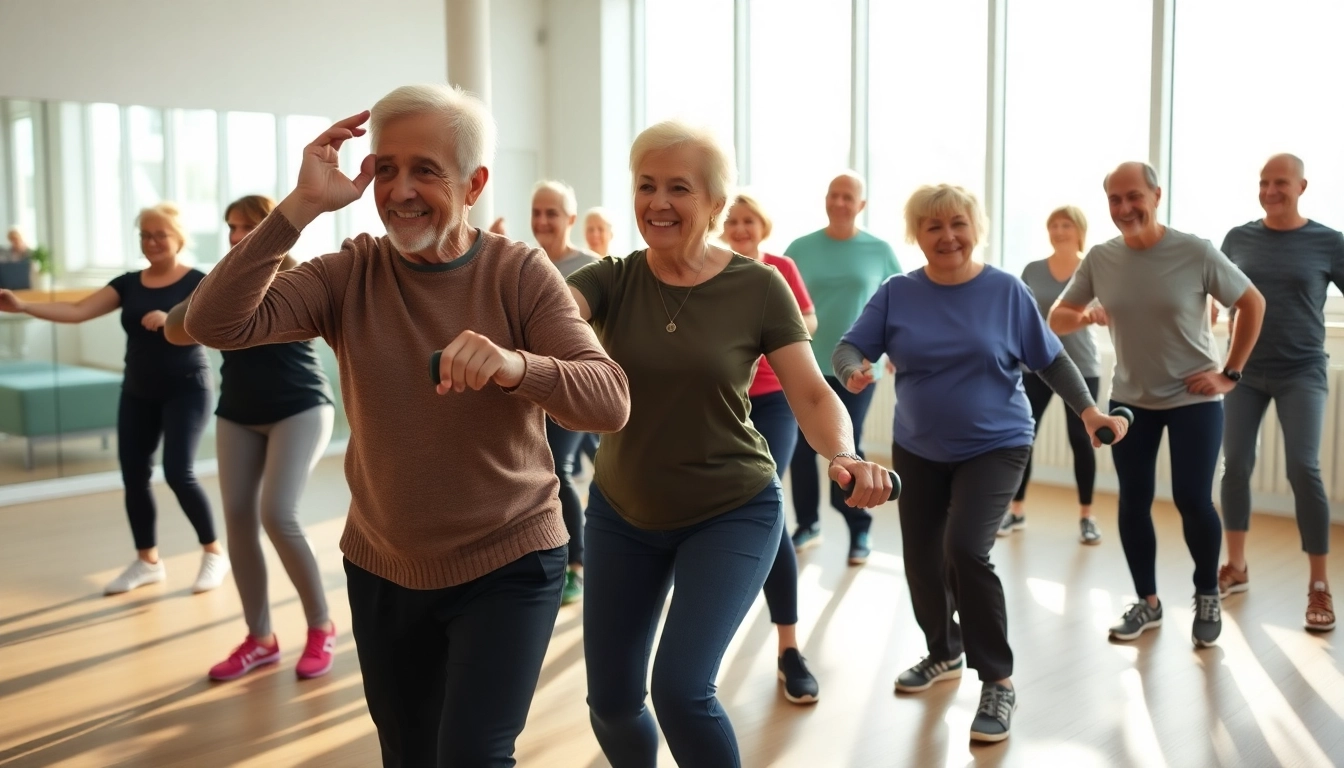Effective Senior Fitness Training: Tailoring Exercise for Healthier Aging
Understanding Senior Fitness Training
As we age, maintaining our physical health becomes increasingly important. Regular exercise plays a crucial role in enhancing the quality of life for seniors, offering numerous benefits that go beyond mere physical appearance. Incorporating Senior Fitness Training into daily routines can help older adults remain active and independent, reduce the risk of chronic diseases, and enhance their overall well-being.
The Importance of Fitness for Seniors
Fitness is essential for seniors to maintain strength, flexibility, balance, and cardiovascular health. Engaging in regular exercise can also prevent falls and associated injuries, improve mental health, and foster social connections through group activities. Additionally, as the body ages, it naturally loses muscle mass, bone density, and flexibility, making it crucial for seniors to adopt fitness routines that counteract these effects.
Common Barriers to Exercise
Seniors often encounter several barriers to regular exercise, including:
- Health Concerns: Chronic conditions like arthritis, heart disease, or diabetes may limit physical capabilities.
- Lack of Motivation: Feelings of isolation or depression can diminish the desire to engage in physical activity.
- Accessibility Issues: Limited access to suitable facilities or safe environments can hinder participation.
- Knowledge Gaps: A lack of understanding about appropriate exercises for their age group can discourage seniors from starting a program.
Physical Benefits of Regular Activity
Engaging in regular physical activity offers a myriad of benefits for seniors, including:
- Improved Cardiovascular Health: Regular aerobic exercises enhance heart and lung function.
- Increased Strength: Strength training helps maintain muscle mass and bone density.
- Enhanced Flexibility: Stretching and mobility exercises increase range of motion and reduce stiffness.
- Better Balance: Activities like yoga and tai chi help improve proprioception, reducing fall risks.
- Mental Health Benefits: Exercise has been shown to reduce symptoms of anxiety and depression and enhance mood through the release of endorphins.
Key Components of a Senior Fitness Program
Designing an effective senior fitness program entails incorporating various types of exercises that cater to the unique needs of older adults. The program should be diverse, engaging, and adaptable to individual abilities.
Aerobic Exercises for Senior Health
Aerobic exercises are crucial for improving cardiovascular fitness and overall endurance. Options suitable for seniors include:
- Walking: A low-impact, easily accessible form of aerobic exercise that can be done both indoors and outdoors.
- Swimming: Provides a full-body workout while being gentle on the joints.
- Cycling: Can be performed on stationary bikes or outside, offering a low-impact option to build endurance.
- Dancing: Fun and social, dancing can significantly improve heart health and enhance coordination.
Strength Training Adaptations
Strength training is vital to help combat muscle loss and maintain functional independence. Key points to consider include:
- Use of Resistance Bands: These can be adjusted for resistance and are safer than free weights for many older adults.
- Seated Exercises: Performing strength training while sitting can provide extra support while allowing effective muscle engagement.
- Low Weights with Higher Repetitions: Engaging in lighter weightlifting with more repetitions can enhance strength without straining the body.
Flexibility and Balance Workouts
Flexibility and balance exercises are essential components of senior fitness. They not only improve mobility but also help in preventing falls:
- Stretching: Gentle stretching routines can improve flexibility and range of motion.
- Yoga and Tai Chi: Both practices enhance balance, flexibility, and concentration, significantly benefiting mental health.
- Balance Exercises: Simple activities, such as standing on one foot or heel-to-toe practice, can enhance stability and confidence.
Safe Practices in Senior Fitness Training
Safety is paramount in any fitness program, particularly for seniors. Understanding how to exercise safely ensures that seniors can enjoy the benefits of fitness without risking injury.
Assessing Individual Fitness Levels
A comprehensive assessment should be conducted before starting any senior fitness program to establish individual fitness levels. This can include:
- Medical History Review: Identifying pre-existing conditions that might affect exercise routine.
- Fitness Assessments: Evaluating strength, flexibility, balance, and endurance through specific tests to create a baseline.
Recognizing Medical Considerations
With aging often comes an array of medical concerns. It’s crucial to tailor fitness programs to include:
- Low-intensity Options: Start with lower-intensity activities and gradually increase them as fitness improves.
- Hydration and Nutrition: Educate seniors about the importance of hydration and proper nutrition in supporting their fitness goals.
- Monitoring Response: Pay attention to any signs of discomfort or stress during workouts, making adjustments as necessary.
Creating a Supportive Environment
A supportive environment can enhance the effectiveness of a senior fitness program. Considerations include:
- Accessible Locations: Ensuring that exercise locations are easy to reach and navigate.
- Group Classes: Promoting social engagement through group classes can create a sense of community.
- Incorporating Family: Encouraging family involvement or observation can motivate seniors to engage in fitness.
Techniques for Engagement in Senior Fitness Training
To ensure seniors remain motivated and engaged, fitness programs must incorporate elements that resonate with their interests and capabilities.
Incorporating Games and Activities
Engaging fitness programs can include playful elements that encourage participation:
- Fitness Challenges: Friendly competitions or challenges can make exercising more enjoyable.
- Pet Therapy: Incorporating therapy animals during workouts can enhance mood and motivation.
- Functional Movement Games: Games that mimic real-life tasks, such as reaching or bending, can be both enjoyable and beneficial.
Building a Community Around Fitness
Creating a community among participants can enhance motivation and support. This can be achieved through:
- Group Outings: Organizing walking groups or fitness challenges can foster camaraderie and accountability.
- Buddy Systems: Pairing individuals can encourage mutual support and motivation during workouts.
- Celebrating Milestones: Recognizing participant achievements can bolster community spirit and individual motivation.
Encouraging Consistency and Motivation
Consistency is key in establishing a successful fitness routine. Strategies to encourage ongoing participation include:
- Setting Realistic Goals: Work with seniors to set achievable and meaningful fitness goals.
- Providing Feedback: Regularly check in and provide feedback to reinforce progress and celebrate achievements.
- Diverse Schedule: Offering a variety of classes or activities to keep interest levels high.
Measuring Success in Senior Fitness Training
Tracking progress in senior fitness training is essential for understanding effectiveness and motivating participants. Utilizing various metrics can provide insights into advancements and areas for growth.
Tracking Progress: Techniques and Tools
Consider employing the following techniques to monitor individual progress:
- Fitness Journals: Encourage seniors to maintain records of their workouts and achievements.
- Regular Assessments: Conduct periodic re-evaluations to measure improvements in strength, endurance, and flexibility.
- Technology Assistance: Utilize apps or wearable devices to track activity levels and health metrics.
Adjusting Programs Based on Feedback
Regularly soliciting participant feedback allows trainers to fine-tune programs based on needs and preferences:
- Feedback Surveys: Implement surveys to collect participant insights on classes and routines.
- Open Dialogues: Encourage an environment of open communication regarding effectiveness and enjoyment of exercises.
Celebrating Achievements to Boost Morale
Recognizing accomplishments is essential for maintaining motivation. Consider these strategies:
- Milestone Celebrations: Organize events to celebrate fitness milestones, offering participants recognition and community support.
- Highlighting Success Stories: Sharing progress and transformation stories can inspire others within the fitness community.
- Providing Incentives: Offering tangible rewards or certifications can also enhance motivation and participation.



